How To Form Piano Scales - Major, Minor & Chromatic
In this lesson, we will learn how to build various piano scales. Firstly, we will learn major and minor scales. There are different types of minor scales. They include natural or pure minor scales, harmonic minor scales and melodic minor scales. Lastly, we will learn how to form what is known as chromatic scales.
Before we go any further let's talk about half steps and whole steps.
Highly Recommended: Go here for the BEST piano/keyboard course I’ve seen on the Internet.
A half step, also called a semitone is the distance from one pitch to the nearest pitch either up or down. For example the distance between A and A sharp on your piano is a half step. The distance between G and G sharp is a half step. The distance between B and B flat is a half step, or semitone. The same can be said for the distance between E and F, B and C, and so on. In other words if you move to the key to the immediate left of a key on your keyboard, what you're doing is moving a half step or semitone lower. If you move to the key that is to the immediate right of a key on your keyboard, you're moving a half step or semitone higher.
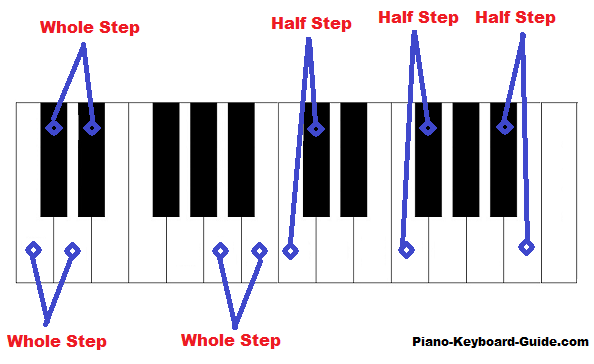
How about whole steps? Two half steps make up a whole step. A whole step is also known as a whole tone. Examples of whole steps are the distance between C and D, D and E, F and G, G and A, and A and B. If you look closer at your keyboard you will notice that to form a whole step, you skip a key.
It's now time to move on to major and minor piano scales. These scales are known as diatonic scales. A diatonic scale is an eight-note scale composed of seven pitches and a repeated octave. The diatonic scale includes five whole steps and two half steps for each octave, in which the two half steps are separated from each other by either two or three whole steps, depending on their position in the scale.
How To Form Major Piano Scales
Let's start with the major scale. A major scale consists of eight notes arranged in a pattern of whole steps and half steps. To construct a major scale, start with the name of the scale. This is also called the root. The root is followed by a whole step, then another whole step, a half step, a whole step, a whole step, a whole step and finally a half step. The formula for forming a major scale is W-W-H-W-W-W-H or whole step - whole step - 1/2 step - whole step - whole step - whole step - half step.
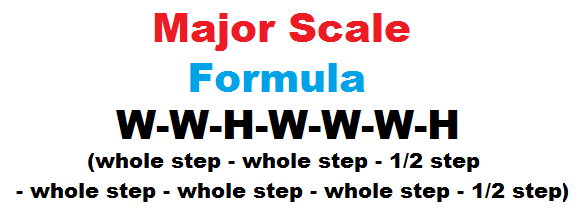
Let's try this in the key of C. In the key of C, you start with the root note C, then you move one whole step to D, a whole step to E, a half step to F, a whole step to G, a whole step to A, a whole step to B, and lastly a half step to C. The notes of the C major scale are C D E F G A B C .
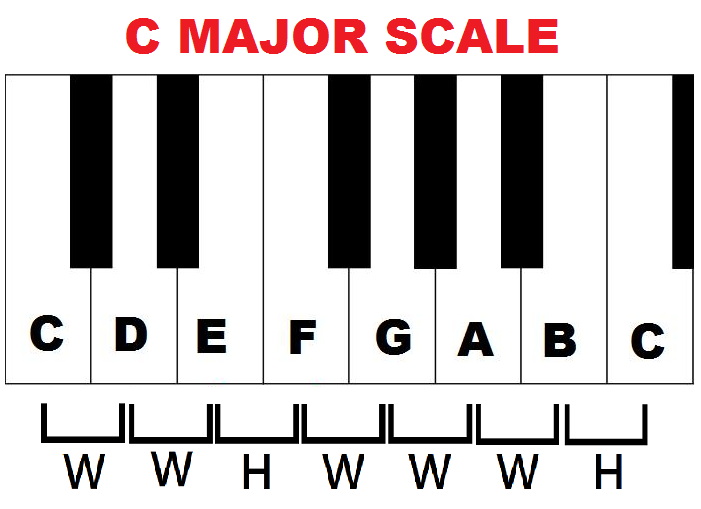 C major piano scale and formula
C major piano scale and formulaHow about the key of G? In the key of G, you start with the root note G, then you move one whole step to A, a whole step to B, a half step to C, a whole step to D, a whole step to E, a whole step to F#, and lastly, a half step to G. The notes of the G major scale are G A B C D E F# G.
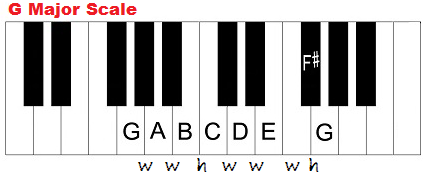
As long as you understand the formula for forming a major scale, you should be able to start on any key on your piano and form a major scale. Practice makes perfect.
How To Form Minor Piano Scales
We now move to minor piano scales. Each major key has what is known as a relative minor. For example the relative minor of C is A minor. The relative minor of G is E minor. Major scales and natural minor scales consist of the same notes. The difference is the note on which the scale starts. The relative minor scale is built upon the sixth tone of the major scale. For instance, the notes of the C major scale are C D E F G A B. The sixth note in that scale is A. The relative minor of C major, A minor starts on that sixth note, A and moves to B C D E F G, then back to A. The difference between the major and minor scales is the pattern of whole steps and half steps.
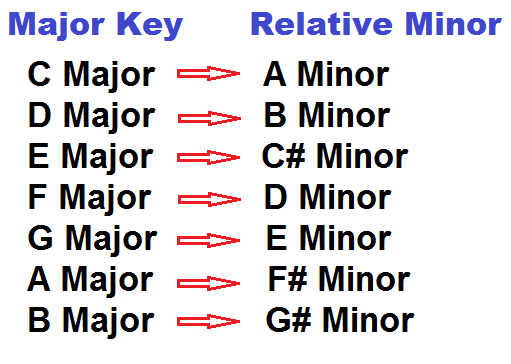
In a natural or pure minor scale the formula is whole step - half step - whole step - whole step - half step - whole step - whole step or W-H-W-W-H-W-W. For example, in the key of E minor, you start with the root note E, then you move one whole step to F sharp, a half step to G, a whole step to A, a whole step to B, a half step to C, a whole step to D, and finally a whole step to E. The notes for the E natural minor scale are E F# G A B C D E. These are the same notes of its relative major, the G major scale. E minor is the relative minor of G major.
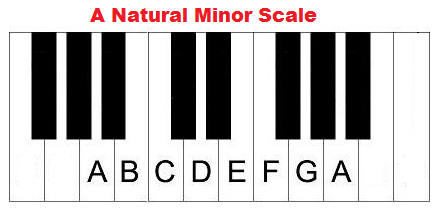 A natural minor piano scale
A natural minor piano scaleThere is another type of minor scale known as the harmonic minor scale. Similar to the natural or pure minor scale, the harmonic minor scale starts on the sixth degree of its relative major. The only difference between the natural minor and harmonic minor scale is the 7th tone of the scale. In a harmonic minor scale the 7th tone is raised by a half step. For example, in the A harmonic minor scale instead of playing G, you play G sharp. While the notes of the A natural minor scale are A B C D E F G, in the harmonic minor scale it's A B C D E F G# A. The formula for a harmonic minor scale is whole step - half step - whole step - whole step - half step - whole step and a 1/2 step - half step.
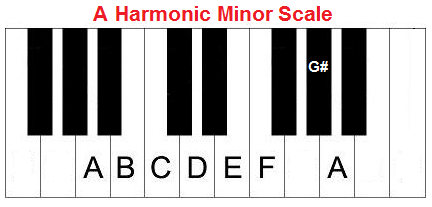 A harmonic minor piano scale
A harmonic minor piano scaleWe now move on to the third type of minor scale, known as the melodic minor scale. Like the natural minor and harmonic minor scales, the melodic minor scale begins on the 6th degree of the relative major scale. This scale is quite interesting. When descending on your piano, you use the same notes of the natural or pure minor scale. But when ascending the 6th and 7th tones are raised by half a step. The formula for a melodic minor scale is whole step - half step - whole step - whole step - whole step - whole step - half step. Or W-H-W-W-W-W-H. The descending formula is the natural minor scale formula backwards.
For instance, in an A melodic minor scale the notes are A B C D E F# G# A (ascending), and A G F E D C B A (descending).
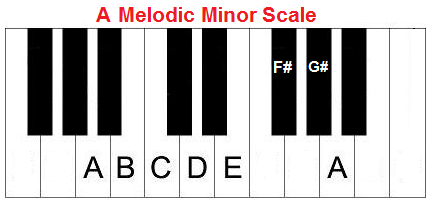 A melodic minor piano scale
A melodic minor piano scaleChromatic Piano Scales
Before we end let's take a look at one of the most straightforward scales one can form on the piano. This is known as the chromatic scale. To form this scale you simply move in half steps. It doesn't matter where you start on your piano, just move in half steps. Depending on whether you are ascending or descending you use either sharps or flats. Sharps for ascending and flats for descending. When ascending you use sharps and natural signs. When descending you use flats and natural signs.
For instance, in the key of C, the chromatic scale is C C# D D# E F F# G G# A A# B C (ascending), and C B Bb A Ab G Gb F E Eb D Db C (descending).
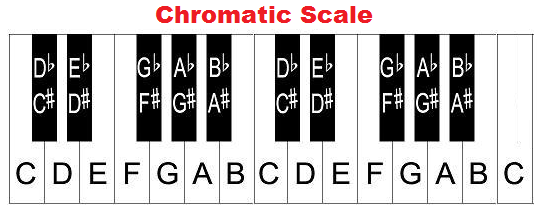 Chromatic piano scale
Chromatic piano scaleHopefully, you now have a clearer understanding of how to form major scales, natural minor, harmonic minor and melodic minor scales, and chromatic scales. You may want to watch this video again and practice what we've discussed here in all keys as you progress.
Search This Site:

Recommended For You
Learn to play piano and keyboards:
Click here to learn how to play keyboards and piano (with Piano For All).
Go here to buy a Yamaha keyboard.
Check out How To Read Music Fast: A 4-Step Beginner's Guide To Reading Music Quickly And Easily.





New! Comments
Have your say about what you just read! Leave me a comment in the box below.